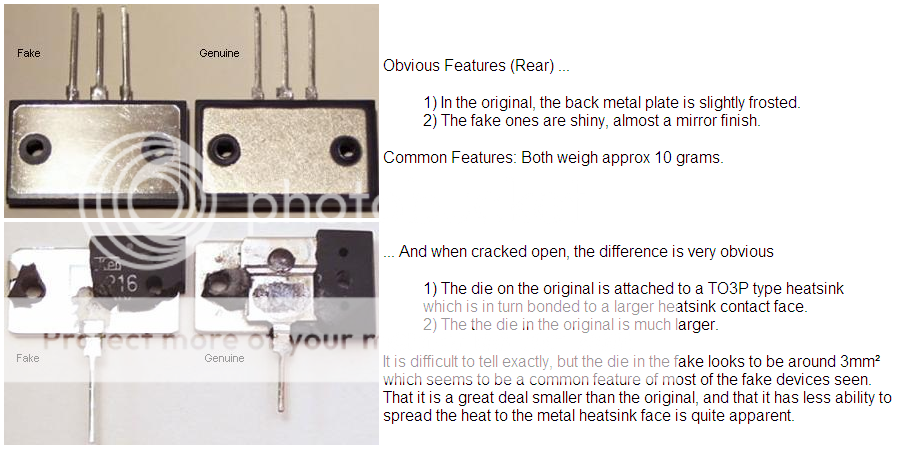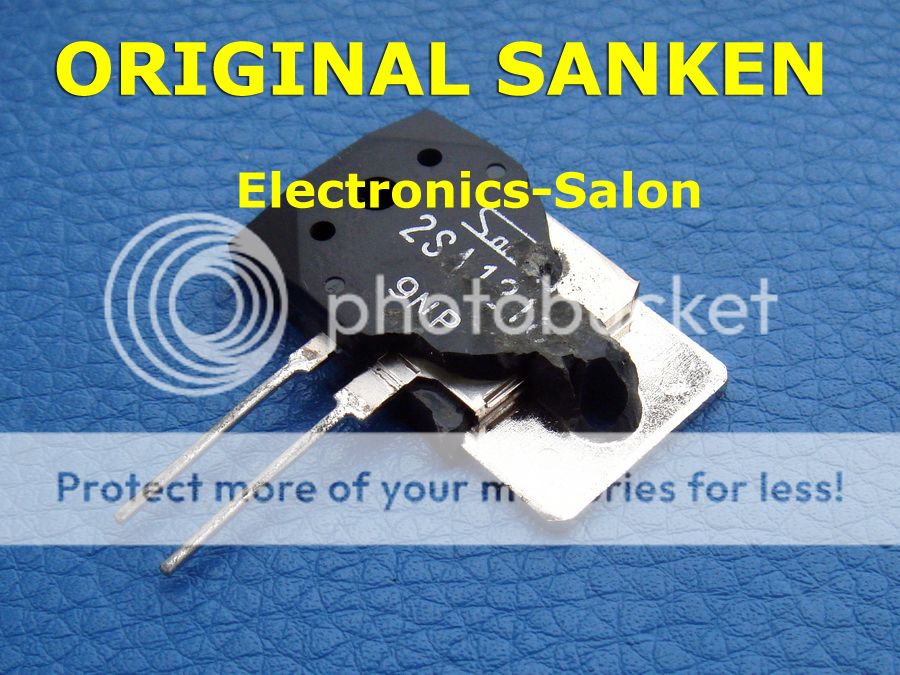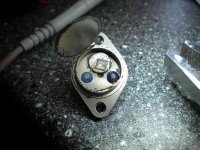Fakes from MCM
Beware all. MCM is still shipping fake semiconductors. I got an MJ15023 that has fake written all over it last week. Wouldn't be so bad if I had not paid $5.49 for it. I thought they had cleaned up their act when this first broke, but then, maybe not. Kind of makes you wonder how much else in that catalog is fake.
Beware all. MCM is still shipping fake semiconductors. I got an MJ15023 that has fake written all over it last week. Wouldn't be so bad if I had not paid $5.49 for it. I thought they had cleaned up their act when this first broke, but then, maybe not. Kind of makes you wonder how much else in that catalog is fake.
2SA1216 2SC2922

Original 2SA1216/2SC2922

So an obvious way to detect a fake (or not) is to slice off a small section of the top centre of the transistor.
If it shows double thickness, it is probably genuine.
If only a single thickness, FAKE!
Andy
.EDIT -- Maybe not ! Is the member, Sunmans, the same as the EBAY vendor, electronics-salon, whose name appears on the picture and on his listings???????
http://cgi.ebay.co.uk/2SA1216-2SC29...emQQptZLH_DefaultDomain_0?hash=item3cab2d18b1
.
Last edited:
So an obvious way to detect a fake (or not) is to slice off a small section of the top centre of the transistor.
If it shows double thickness, it is probably genuine.
If only a single thickness, FAKE!
Andy
.EDIT -- Maybe not ! Is the member, Sunmans, the same as the EBAY vendor, electronics-salon, whose name appears on the picture and on his listings???????
2SA1216 & 2SC2922 Original SANKEN Transistor, x 2 PCS on eBay (end time 17-Mar-10 12:06:21 GMT).
Are there any publications from Sanken itself regarded this subject in general (so as any advices to identify)?
fake MJ15023 and 22's are all over . I bought these from ondaradio.es , barcelona, stay away from them, it's all junk
That looks more like a "good copy" than an outright fake. The die looks very close (and it may be 15023 die or similar), they are using a heat spreader, and they have the two bond wires on the emitter (which the real PNPs do). Counterfieters usually don't go to that much trouble. I would label it "fake" if the can said "M" or "ON" on it, but there are third parties making MJ15023's. And some of them (Harris, RCA, etc) were good. The only way to know is to test one. The fakes I recieved had the white goo, no heat spreader, and a 2955-size die. And from the poor screen-printing job, quite obvious before popping the covers.
also if anybody is interested, Fairchild Semiconductor makes a licensed 2SA1943 and 2SC5200. those will have a fairchild logo on them and beta codes are O and R. so if you see these devices with a slanted F on them, they're not as likely to be fakes as the toshibas. if you want to be more positive, order them with the fairchild numbers FJL4215 (for the 2SA1943) and FJL4315 (for the 2SC5200)
WOW!
Counterfeit american transistors, sold by an american retailer to an american
buyer
How the heck can the chinese counterfeiters break into that chain?
It is always good to check if a dealer is franchised for a particular product:
Power Management ICs, Power Semiconductors, Signal Path ICs, Lighting and Display, Logic, Optoelectronics, Fairchild Semiconductor - Global Leader in Power Optimization
Scroll to the bottom:
ON Semiconductor: Find Local Sales Support
I've got an old Soundcraftsman amp with a repaired channel that has Toshiba 2SD424 and 2SB554 outputs. The other channel has the remarked Toshiba transistors with Soundcraftsman markings. A Soundcraftsman #5 tested shorted and I cut it open to find what looks like white/clear silicone covering the die. It's been a long time since I last cut open some TO3's but I've never seen this type of coating. Is it normal or more common with fakes?
different manufacturers have different processes. some transistors and flat packs have a silicone goop in them that never hardens, kind of like the weatherproofing goop in some types of harsh weather rated coax cable and telephone cable. it is also stable at high temperatures, so it stays in place, but touch it, and it's like a thick glue that never sets and sticks to everything. it's like Acme Wile E Coyote glue.
Hi Pete,
That transistor is probably real. These amps were built using the proper parts distribution channels way back then. Of course, it would be nice if the audio industry didn't deem it necessary to use "in-house numbers" on their parts.
I do recall seeing white silicone sealant inside a few TO-3 cans I opened now and again. There is no way I could remember what was found inside each types. TO-3 transistors are supposed to be hermetically sealed as I recall.
-Chris
That transistor is probably real. These amps were built using the proper parts distribution channels way back then. Of course, it would be nice if the audio industry didn't deem it necessary to use "in-house numbers" on their parts.
I do recall seeing white silicone sealant inside a few TO-3 cans I opened now and again. There is no way I could remember what was found inside each types. TO-3 transistors are supposed to be hermetically sealed as I recall.
-Chris
Call you email the name of the shop where you purchased 2sc2500 in bangalore, since iam planning to start Symasym 5 project latest version
My mail id is : grapheal@gmail.com
My mail id is : grapheal@gmail.com
- Home
- Design & Build
- Parts
- My Transistors, original or copy?

